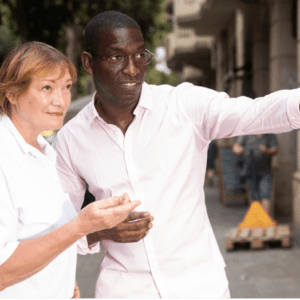Ties That Unite: The Value Of Social Interaction In Everyday Life

Ties That Unite: The Value Of Social Interaction In Everyday Life
August 4, 2021
Even before the lockdowns of the last year and a half, we’ve known that loneliness has been a huge public health threat in both the United States and worldwide. And yes, many older adults were resilient during the pandemic and even took to technology in surprising and beneficial ways. But for many, at best, technology was a temporary, limited balm in an otherwise dreary environment. For example, a study out of the Oregon Center For Aging and Technology recently reported that texts and emails during the pandemic helped lighten the mood of older adults during lockdowns but did not provide the same benefits and level of connection that come from in-person contact. Moreover, a study out of the UK reports that many older adults felt a greater sense of loneliness, and more negative mental health effects, from utilizing online social connections during the pandemic. In fact, they appeared to be worse off than those who spent the pandemic isolated on their own. Between the sense of frustration in mastering the technology and the burnout from excessive digital communication, many were left bereft, finding digital contact no match for the missing in-person social interaction.
In fact, loneliness can have additional negative impacts. It seems to drive older adults into dangerous territory with increased use of opioids and other prescription medications. A new study out of UC San Francisco reports that adults who consider themselves very lonely are much more likely to use prescription painkillers, anti-anxiety meds, and powerful opioids than those who do not feel lonely. In fact, the recommendation from the researchers is that prescribing physicians should consider “social contact prescriptions” rather than medication as a way to halt this slide into the overuse of dangerous drugs. This concern is also matched by recent research out of Singapore that lonely adults may have shorter life expectancy, and shorter health spans before death, than those who do not feel lonely. As one of the lead researchers commented, “We found that lonely older adults can expect to live a shorter life than their peers who don’t perceive themselves as lonely…Furthermore, they pay a penalty for their shorter life by forfeiting potential years of good health.”
On a more positive note, however, it does appear that one antidote for these feelings of loneliness is relatively easy to implement, with positive results. It seems that the “weak ties” of social connections we took for granted before the pandemic- the clerk at the cleaners or the acquaintances you saw at your regular exercise classes- have true value. In an important new article for Kaiser Health News, journalist Judith Graham writes about the importance of casual relationships for older adults and the benefits that can flow from our resumption of spontaneous and intermittent social engagement in our day-to-day lives. Earlier in the year, Atlantic writer Amanda Mull also recognized this concern when she wrote, “tools like Zoom and FaceTime, useful for maintaining closer relationships, couldn’t recreate the ease of social serendipity” that comes from casual, unplanned connections. It’s not so much the close friends that you lost during the pandemic, but rather the “weak ties” with acquaintances or even strangers that give you a sense of being part of a community and allow you to feel connected. These are vitally important to your health and well-being, and even your life expectancy in some cases. So as Graham and others have recommended, get back out there (albeit safely), start a conversation with a stranger, and let the positive emotions from social interaction wash away your feelings of loneliness.







